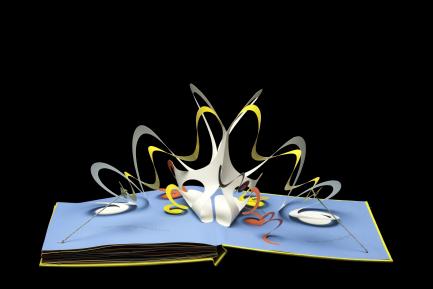Smithsonian Institution Libraries Unveils “Paper Engineering: Fold, Pull, Pop and Turn”
The Smithsonian Institution Libraries opens its new exhibition “Paper Engineering: Fold, Pull, Pop and Turn” in the National Museum of American History June 14. The exhibition features the art of paper engineering in the production of books with moving parts, such as peep shows (pictures viewed through a small hole), volvelles (wheel charts), accordion books and pop-up books, published from the 15th century to modern times. Viewers will receive an in-depth look at the structure and design of pop-up and movable books, with more than 50 works demonstrating the diverse methods designers and paper engineers use to magically transform flat, static images into dynamic, multidimensional forms. “Paper Engineering” will be on display through fall 2011.
Throughout history, books with moving parts were tools used to educate and document complex concepts in science and medicine, as well as to supply teachers with innovative ways of presenting basic arithmetic and reading skills. Several layers of engraved images of body parts and organs as seen in René Descartes’ Renatus Des Cartes de homine (1662), or the inner workings of the mechanisms of a steam locomotive as seen in Hans Blücher’s Moderne Technik (1912), were at one time the most effective ways to visually explain complex concepts of the structure of the body and the machine. Other movables, such as volvelles, as seen in Peter Apian’s Calendarium and Apianus (Astronomicum Caesareum; 1540), were developed to calculate such things as astronomical movement or the change of seasons on a calendar.
Viewers can also relate to movable and pop-up books, which were introduced in the 18th century, as toys whose primary purpose is to entertain children and adults. The exhibition includes flap books with pull tabs and dissolving images that reveal answers to riddles or show cartoon-like characters, such as Dean and Sons’ Cinderella, or the Little Glass Slipper (1850) and Stacey Grimaldi’s A Suit of Armour for Youth (1824).
The exhibition demonstrates how pop-ups and movables contributed to and documented the history of ideas, how those ideas were transferred through the book and how they continue to teach in amusing ways. All the pop-up books are made by hand. Some of the most renowned paper engineers in pop-up history are included, such as Lothar Meggendorfer, Ernest Nister, Harold Lentz and Voitech Kubasta. Also featured are contemporary designers David Carter, Matthew Reinhardt, Robert Sabuda, David Hawcock, Bruce Foster and Chuck Fischer. This exhibition also features two interactive videos, a series of lectures by paper engineers and collectors, and an online blog: http://smithsonianlibraries.si.edu/foldpullpopturn/.
# # #
SI-203-2010

